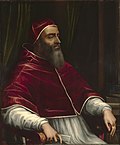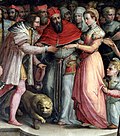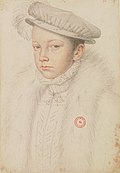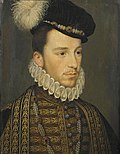Catherine de' Medici
Catherine de'Medici(13 April 1519 – 5 January 1589) was an Italian noblewoman from the powerful Medici family. She became Queen of France as the wife of King Henry II and was the mother of three French kings: Francis II, Charles IX, and Henry III. They were sometimes called "the age of Catherine de' Medici."
| Catherine de' Medici | |||||
|---|---|---|---|---|---|
 Portrait attributed to François Clouet, c. 1555 | |||||
| Queen consort of France | |||||
| 31 March 1547 – 10 July 1559 | |||||
| 10 June 1549 | |||||
| Born | 13 April 1519 Florence, Republic of Florence | ||||
| Died | 5 January 1589 (aged 69) Château de Blois, Kingdom of France | ||||
| Burial | Saint-Sauveur, Blois. Reburied at Saint-Denis in 1610. | ||||
| Spouse | |||||
| Issue | |||||
| |||||
| House | Medici | ||||
| Father | Lorenzo de’ Medici, Duke of Urbino | ||||
| Mother | Madeleine de La Tour d'Auvergne | ||||
Born in Florence, Italy, Catherine married Henry in 1533, arranged by her relative, Pope Clement VII. When Henry became king in 1547, Catherine was pushed aside by his mistress, Diane de Poitiers. But after Henry's death in 1559, Catherine took control as the mother of young King Francis II. After Francis died a year later, she became regent for her second son, Charles IX, and later helped her third son, Henry III, rule as king.
During her time as queen and regent, France was troubled by wars between Catholics and Protestants (Huguenots). At first, Catherine tried to make peace with the Protestants, but later turned to harsher measures. She is often blamed for the St. Bartholomew's Day Massacre in 1572, when thousands of Protestants were killed, though it is unclear how much she was involved.
Despite many difficulties, Catherine kept the French monarchy from collapsing. She was also a supporter of the arts and tried to improve the image of the monarchy through culture and building projects. Many historians consider her one of the most important women in Europe during the 16th century. Without her, the Valois family might not have stayed in power.
Children
Catherine de' Medici married Henry, Duke of Orléans, who later became Henry II of France, on 28 October 1533 in Marseille. Together, they had ten children, of which four sons and three daughters survived to marry. Three of her sons became kings of France, while two daughters married kings and one married a duke.
Catherine outlived all her children except Henry III, who died just seven months after her, and Margaret, who inherited her strong health. Among her children, Victoire and Jeanne were twin daughters born in 1556. Unfortunately, Jeanne was stillborn, and Victoire died shortly after birth. The birth nearly killed Catherine, and after this, doctors advised her and Henry to have no more children.
- Francis II, King of France (19 January 1544 – 5 December 1560). Married Mary, Queen of Scots, in 1558.
- Elisabeth (2 April 1545 – 3 October 1568). Married Philip II, King of Spain, in 1559.
- Claude (12 November 1547– 21 February 1575). Married Charles III, Duke of Lorraine, in 1559.
- Louis, Duke of Orléans (3 February 1549 – 24 October 1550). Died in infancy.
- Charles IX, King of France (27 June 1550 – 30 May 1574). Married Elizabeth of Austria in 1570.
- Henry III, King of France (19 September 1551 – 2 August 1589). Married Louise of Lorraine in 1575.
- Margaret (14 May 1553 – 27 March 1615). Married Henry, King of Navarre, the future Henry IV of France, in 1572.
- Hercules, Duke of Anjou (18 March 1555 – 19 June 1584), renamed Francis when he was confirmed.
- Victoire (24 June 1556 – 17 August 1556). Died in infancy.
- Jeanne (24 June 1556). Stillborn[1]

Catherine De' Medici Media
Giulio di Giuliano de' Medici, Pope Clement VII, by Sebastiano del Piombo, c.1531. Clement called Catherine's betrothal to Henry of Orléans "the greatest match in the world".
Henry, Duke of Orléans, by Corneille de Lyon. During his childhood, Henry spent almost four and a half years as a hostage in Spain, an ordeal that marked him for life, leaving him introverted and gloomy.
Catherine de' Medici (age 30s), as Queen consort of France (1550s). Portrait at the Uffizi Gallery. As Catherine approached 40 years of age, a Venetian envoy essayed his impression: "Her mouth is too large and her eyes too prominent and colourless for beauty [...] but a very distinguished-looking woman, with a shapely figure, a beautiful skin and exquisitely shaped hands."
Francis II of France, by François Clouet, 1560. Francis found the crown so heavy at his coronation that four nobles had to hold it in place as he walked up the steps to his throne.
Charles IX of France, after François Clouet, c. 1565. The Venetian ambassador Giovanni Michiel described Charles as "an admirable child, with fine eyes, gracious movements, though he is not robust. He favours physical exercise that is too violent for his health, for he suffers from shortness of breath".
Jeanne d'Albret, Queen of Navarre, by François Clouet, 1570. She wrote to her son, Henry, in 1572: "All she [Catherine] does is mock me, and afterwards tells others exactly the opposite of what I have said ... she denies everything, laughing in my face ... she treats me so shamefully that the patience I manage to maintain surpasses that of Griselda".
Henry, Duke of Anjou, by Jean de Court, c. 1573. As Henry III, he often showed more interest in pious devotions than in government.
References
- ↑ Heritier, 48, has the twins' deaths the other way round.









